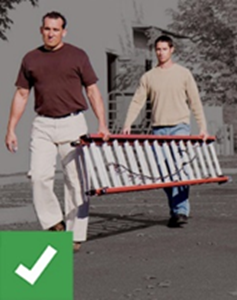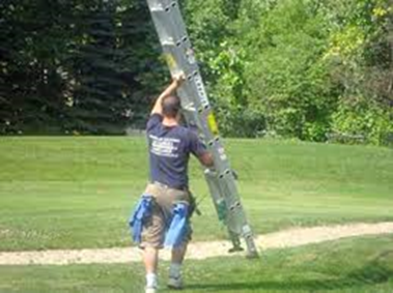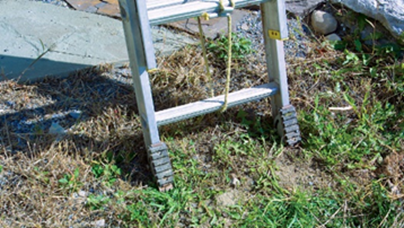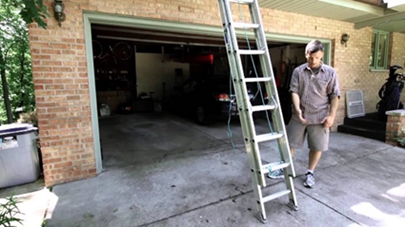How To Use Ladders Safely
- Granite State Painters

- Oct 11, 2022
- 5 min read
Did you know that every year there are around 164,000 emergency room treated injuries and 300 deaths a year in the United States that all are caused by falls from ladders?
That is why it's very important to understand the proper and safest way to handle extension ladders and a-frames/step ladders to avoid any injuries or damages. Here at Granite State Painters, we always incorporate that extra step to be as safe as possible to prevent any accidents for the safety of our employees and clients! This blog will also include how to safely transport extension ladders to jobs.

Extension Ladders:
An extension ladder is a portable ladder that is adjustable in length, it consists of two ladders where one part will travel through a guide and is adjusted by a rope that is tied on to a rung of the ladder.

Now that we went over the basics of an extension ladder, let's get into how to safely and properly use one! First thing you want to do before using a ladder is check and make sure that everything is in good condition. For example, look at the anti-slip safety feet, rope and pulley system, rung locks, the rungs, side rail, base, and fly section. Once you have determined that the ladder is in good condition, it is ready to be used. If you must move the ladder and are carrying it vertically, you need to be aware of your surroundings and look out for anything your ladder could get stuck on, such as branches of a tree or powerlines. Same goes for carrying it horizontally, keep your distance from the house or other workers around you to prevent any damages or injuries to the environment around you.
No matter the situation, if you are struggling with carrying a ladder or adjusting it, don’t be afraid to ask someone else to help you. This will help avoid an accident! Once we get the ladder where we want it, we want to make sure that the anti-slip safety feet are being used in a correct manner. If you are on a hard surface such as pavement, you want to have these feet flat. If you are working in a grassy area, you want to flip the feet so the teeth are buried into the ground.
Never place one of these ladders on any unstable surfaces. You always want the feet of the ladder to be fit to ground so the ladder cannot wobble. This will help prevent a ladder falling. Once the ladder is correctly pitched (75-degree angle or a 4-1 ratio) you want to always face the ladder when ascending or descending it. Trying to walk down a ladder with your back to the rungs is very dangerous, which brings up another precaution that everyone should take while on a ladder. We need to always have three points of contact on the ladder example, two hands and one foot or two feet and one hand on the ladder while on it. Once you are doing the work on the ladder you never want to be leaning off trying to reach something out of your range, our range is always within our wingspan and will help you stay safe while on the ladder. Lastly, extension ladders should never be used during rain, storms, or in high winds because the weather can cause the rungs to be slick and cause someone to slip off the ladder, high winds can be strong enough to knock a ladder off the side of the house which could seriously injury someone or cause major damage to the property
A-Frame/Stepladders:
An A-frame/stepladder is a ladder that is self-supporting and portable, but not adjustable. They can range from 4-20 feet in length. With most ladder deaths occurring at heights 10 feet or less, it is important to know the safest ways to use a stepladder.

Before any use of the stepladder, you want to check the condition and make sure that this is a safe working ladder. This is important because, say one of the braces or spreader lock had broken on the ladder, this would make it less stable, especially when body weight is added making it more likely to kick out on you which could possibly cause injuries. When placing a step ladder for use, you want the four feet to be balanced on a stable surface, if the feet aren’t stable or on unstable ground and you start using the ladder, as soon as your weight shifts and creates an imbalance with the four feet of the ladder there is a chance of the ladder kicking out on you. Once you properly set your stepladder you want to keep your body weight centered in the middle of the ladder to help prevent it from kicking out. Never go on the top/top rung of a step ladder; this is extremely unsafe. Instead, get another ladder that will help you reach the target. You can have tools on you or on your ladder when using it, but after you are finished using the ladder you should remove any tools from it to prevent anything falling off a ladder onto someone or something.

Transporting Ladders Safely to the Job:
The best way to transport a ladder from your shop to a job is having a van or truck with roof racks. You're also going to want a 6ft stepladder and ratchet straps.

The 6ft stepladder will help you be able to stack the extension ladders on the top of the roof rack, depending on the weight and size of the ladder this may be a two-person job. When stacking these ladders, the order you want is longest to shortest with the boots of the ladder to hang over your front windshield. Once ladders are all stacked on the rack of the van you are going to use the ratchet straps to tie and hold down these ladders to prevent them from coming off while operating the vehicle. While driving, stay cautious, drive the speed limit, and take wide corners slowly. Once you are at the jobsite and are at the point of taking ladders off the van, you’ll want one person on top guiding the ladder on the roll bar and another person on the ground guiding the ladders down the roll bar. Take your ladders to an appropriate place that the owner approves of and make a neat stack largest to smallest!
Thank you for reading, stay tuned for our next blog post! Feel free to comment any questions/comments/suggestions.
Phone: (603) 534-8977
E-Mail: admin@granitestatepainters.com
Or Click Here to request a FREE estimate online!
Written by Richard Camarato, GSP Employee













Comments